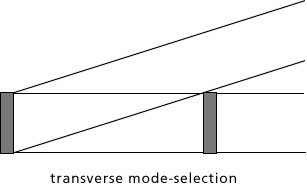It is easiest to consider the resonator as an enclosed box with highly reflective walls. The laser wavelengths are much shorter than this box can realistically be: this induces many different modes or oscillations (technical limitations are important here but more significant is the fact that sufficient intensification is only possible if the laser medium has a certain minimum volume). The laser radiation is then no longer aligned as a ‘pencil’ of light.
Optical Resonator
In order to select a preferential direction, ‘open’ optical resonators are used: two mirrors are set up parallel to each other centred along the same optical axis at a distance much larger than the mirror diameters. The portion of the radiation which is not emitted virtually parallel to the optical axis leaves the optical resonator very quickly and is not intensified any further. Open optical resonators thus only effect the radiation which is fed back almost parallel to the optical axis and discriminate in favour of a particular beam mode with all or most of the other modes being suppressed.
The cross-sectional intensity distribution of the laser radiation field is not homogenous: the intensity is modulated transverse to the propagation direction and decreases steadily at the edges rather than abruptly. This is due to diffraction which always occurs during propagation and is related to the wave-like nature of light. Intensity distributions which can be reproduced after one pass through the resonator are known as the native modes of the optical resonator. These native modes can be approximately described in Cartesian coordinates using Gauss-Hermite functions or in cylindrical coordinates using Gauss-Laguerre functions.
The laser radiation is reflected back and forth within the optical resonator with partial waves from individual passes overlapping each other. When the wavelength of the radiation field is a multiple of twice the distance between the mirrors, the partial waves overlap constructively, otherwise they overlap destructively. This leads to a wavelength selection - the resonator thus restricts both the direction of propagation and the frequency of the laser light. The non-linear interaction of the laser beam field with the active medium reduces the bandwidth in addition to limiting the frequency. In highly stable lasers, a bandwidth of under 1 Hz can be achieved (at an average frequency of approximately 5x1014 Hz).
One of the mirrors is usually highly reflective while the other mirror is finitely reflective and lets some of the radiation through. The transmission from this output mirror can be anything from less than 1% to 70 - 80% depending on the type of laser. The optimal value for maximum power output depends on the intensification in the active laser medium and on the losses due to absorption, scattering and diffraction. Too large a transmission reduces the intensity of the radiation field within the resonator and thus in the active volume: spontaneous absorption and other processes which relax the higher laser energy level, prevail over stimulated emissions. If the transmission is too low, the radiation field will be reflected back and forth even more. Absorption at each pass due to contamination, scattering and diffraction, reduces the radiation - the losses increase with each pass (some of the laser radiation does not strike the mirror and is also lost). The amplification and the losses determine the optimal value for the transmission.
 Fraunhofer Institute for Laser Technology ILT
Fraunhofer Institute for Laser Technology ILT